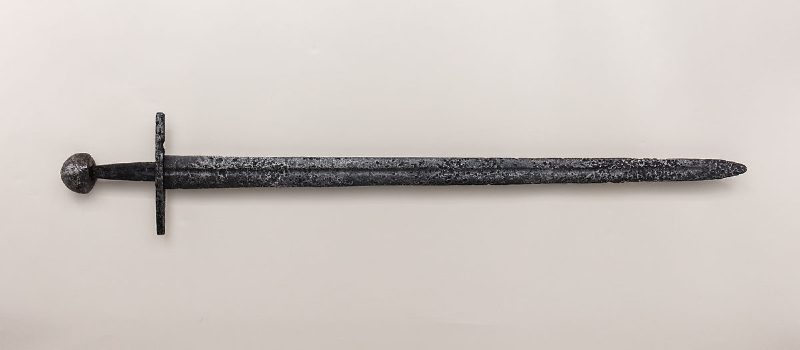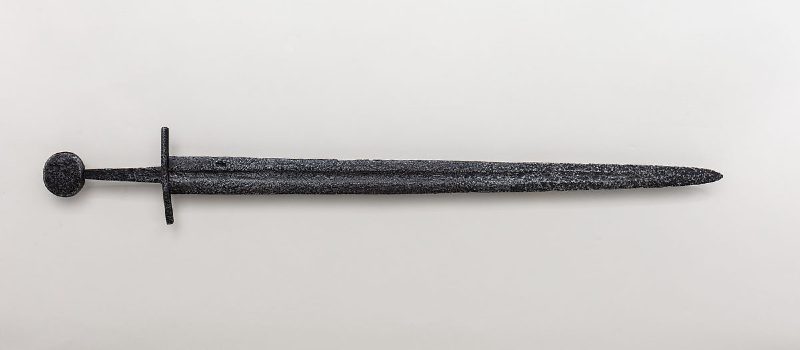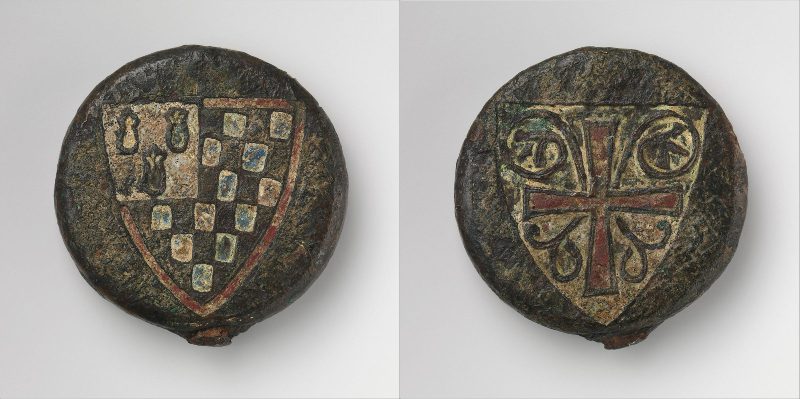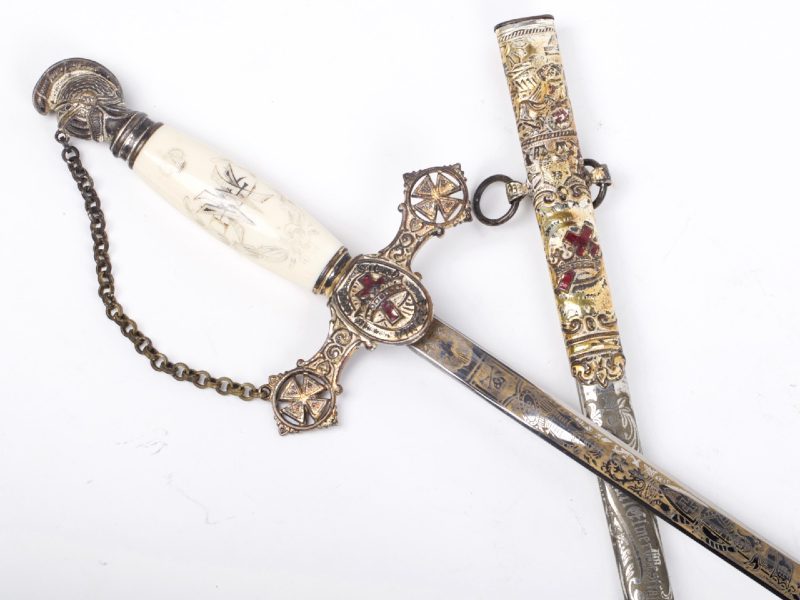Best Knights Templar Swords and Their Historical Uses

What’s in this article?
The Knights Templar were members of the religious military order of knighthood that played a significant role during the Crusades. They were experienced horsemen and proficient in swordsmanship, both in arming swords and the so-called grete war swords.
Let’s explore the history and use of the Knights Templar swords, how they differ from the Masonic society swords, and where to get them online.
Types of Templar Swords
The Templar swords served as the crusader knight’s close-quarters combat weapon. They were generally straight, double-edged, and efficient against chainmail—a body armor composed of hundreds of linked iron rings.
1. Arming Sword

Sometimes called the knightly sword, the arming sword is most distinguished by its single-handed grip. Historical examples had simple cruciform hilts and straight double-edged blades which were typically seen on medieval swords. It served as a cut-and-thrust weapon and would have been devastating against lightly armed opponents.
Most popular around 1000 to 1300, the arming sword developed from the earlier Viking swords and were widely used throughout Europe. As a one-handed sword, it allowed the Templars to use a shield with the other hand which was a common fighting technique in medieval times.
2. Grete War Sword

A relatively early longsword, the grete war sword was a larger weapon that could be used with one or two hands. In the Middle Ages, they were referred to as espée de guerre, grans espée, and so on, distinguishing them from the shorter arming sword. However, these terminologies were not used systematically and difficult to define with certainty.
The relatively modern term longsword generally refers to all swords lightweight enough to use single-handed but with grips long enough for two-handed use. Longswords emerged in the 1250s but only became popular around 1370 to 1440. The medieval knights continued to use them in wars and tournaments.
The Order of the Knights Templar began in 1119 and dissolved in 1314 when their last leader Jacques de Molay was burned at the stake, suggesting that these crusaders might have used the grete war sword for a short time. However, the grete war sword should not be confused with the later Renaissance great swords or two-handers that were longer and not lightweight or balanced for single-handed use.
Some historians suggest that the grete war sword was not an everyday sword of the knight and was primarily used in war. In some illustrations, these long swords were slung on the horse saddle while the Templars wore the arming sword on the waist. They were likely developed against the more efficient armor at the start of the transition from chainmail to plate.
Characteristics of Templar Swords
The Templar sword is characterized by its simple, cruciform shape, reminding us of Christianity’s fiercest knights. The typical crusader sword was the arming sword as the grete war sword only emerged in the later period.
Here are the distinguishing features of the Templar swords:
Material and Construction
Swords need to retain sharp cutting edges and tough to resist cracking. In Europe, swords made entirely of steel were not common before the 14th century. During the crusading period, beginning in the late 11th century, swordsmiths forge-welded different bars of iron and steel. Many swords had blades with an iron core and steel edges, sometimes hardened by quenching.
Hence, the depth of the cutting edges depended on the amount of steel. Also, the use of iron did not improve the toughness of the blade. Medieval swordsmiths lacked measuring equipment and precise process control, so medieval swords had varying carbon content and quality. The art of sword making at Solingen in Germany was well established by the mid-13th century.
Blade Appearance

Templar swords generally had straight double-edged blades which varied in configuration throughout the crusading era. Some had a fuller to lighten the blade without compromising its structure, while others had diamond-shaped cross-sections.
In the First and Second Crusades, the arming swords typically had sharply tapered tips. Plate armor became common during the 13th century, so late crusader swords generally had pointed tips, better suited to thrusting and exposing gaps in plate armor.

The so-called grete war sword, often classified as Oakeshott Type XIIIa, featured a broad blade nearly as wide at the tip as at the hilt and was efficient for delivering slashing blows from horseback.
Size and Weight
An arming sword had a blade length ranging from 75 to 90 centimeters and its hilt about 15 to 17 centimeters long. Wielded with one hand, it weighed approximately 2.5 pounds. On the other hand, the grete war sword usually had a blade length ranging from 93 to 101 centimeters long and a grip about less than 22 centimeters long. These longer swords weighed over 3 pounds and could be used with one or two hands.
Sword Mounting

In the First and Second Crusades, some arming swords had straight quillons—arms of the crossguard—while others curved toward the blade. Wooden handles enclosed the tang, wrapped with cord and leather. The pommel also varied from round to oval or conical shape.
The Templar swords often had inlaid cross designs on the pommel. The sword of Pierre de Dreux, a notable figure in the Baron’s Crusade, had a pommel featuring his arms and a crusader’s cross on the reverse. Some historical grete war swords of a Templar Knight also featured the cross on the pommel.
The Templars generally carried their swords in a scabbard on the left side, hung by a sword belt or leather straps. When fighting on horseback, they wore the arming sword on the left side of their waist, while the grete war sword slung from the saddle. The scabbard was often made of wood covered with leather, with a metal chape at the tip.
Best Knights Templar Swords Available Online
The Templar swords are among the popular medieval weapons in historical reenactment, live-action role-playing or LARP, and cosplay. The arming sword also remains relevant among the practitioners of HEMA or Historical European Martial Arts, mainly in sword-and-buckler fighting.
We rounded up the best Templar swords to help you find the perfect weapon for stage combat, cosplay, LARP, and beyond.
1. Best Overall: Type XIIIa War Sword

If you’re looking for a longsword type of crusader sword, this war sword can be a good choice for you. It has a 9260 spring steel, which is durable, tough, and corrosion-resistant. It features a relatively broad blade similar to historical swords, so it naturally comes with a narrow tang instead of full-tang blade. Still, it can withstand targets like tatami mats and bamboo.
However, it is quite short for a grete war sword with its overall length of 109 centimeters and a blade length of 83 centimeters. Still, it could be ideal for ones who prefer a weapon that allows two-handed use rather than the typical arming sword. For a budget of around $400, you’ll have a sword modeled after an Oakeshott Type XIIIa and a practice sword for honing your longsword skills.
2. Best Premium: Darksword Armory Templar Sword

Are you looking for a powerful cutting sword? This Templar sword has good flexibility, toughness, and springiness, making it ideal for test cutting practice. Constructed from 5160 spring steel, it is a low-chromium and medium carbon steel blade. It is more corrosion resistant than the 1095 high carbon steel and is therefore ideal if you want your sword to last longer.
This Templar sword measures about 116 centimeters with its blade about 91 centimeters long, the average length of an arming sword. It also features an octagonal pommel, leather-wrapped grip, and wooden scabbard covered with leather. For a budget of less than $650, you’ll have a Templar sword for backyard cutting, collection, and beyond.
3. Best on a Budget: Templar Arming Sword

One of the best swords for collectors, this arming sword features a Templar cross on the pommel. It features a blade constructed from EN45 steel which has silicon that contributes to its toughness. For a budget of less than $200, you’ll have a reliable sword for backyard cutting.
However, an EN45 blade is not that hard and would not hold its cutting edge for long. It would require frequent re-sharpening, but it is more corrosion resistant than higher carbon steel blades.
4. Best for Stage Combat: 12th-Century Crusader Sword

Are you looking for a Templar sword for stage combat? This crusader sword features an EN45 steel blade that is tough and resilient. It has an overall length of 95 centimeters and a blade length of 78 centimeters, the average size of an arming sword. It features the classic cruciform hilt, one-handed grip, and wooden scabbard covered with leather. For a budget of around $160, you’ll have a Templar sword for historical reenactment, cosplay, and beyond.
5. Best for LARP: Crusader Foam Sword

If you want to play the role of a Templar warrior, this crusader sword is perfect for you. Its blade material consists of high-quality closed-cell foam and a fiberglass core, making it safe for light sparring with a partner. However, it only has a 55-centimeter blade, making it short for an arming sword. Still, it is a versatile foam sword that you can use in LARP and cosplay, allowing you to play several characters, from a crusader to a medieval knight and a hero.
History of the Knights Templar Sword
The Knights Templar sword remained influential long after the crusader knights were gone. By the late 19th and early 20th centuries, the members of the Masonic organization wore society swords, which became known as the Knights Templar swords.
The Crusader Sword and Military Orders
The Crusades were a series of religious wars which established Christian kingdoms in the Muslim-dominated eastern Mediterranean. After the First Crusade from 1095 to 1099, several Christian states were established in the Holy Land—in Palestine. However, these states lacked military force, so Christian pilgrims suffered attacks from Muslim raiders.
Military orders consisted of members that fulfilled their religious vows and knightly duties. Founded in 1119, the Knight Templar was the first of these orders and protected Christian pilgrims traveling to and from Palestine—a region that included parts of Israel, the West Bank, and the Gaza Strip. The Order was named after the Temple of Jerusalem.
The Hospitallers, founded in 1113, and the Teutonic Knights, founded in 1190, were initially established to care for sick pilgrims but were later militarized. These knights, especially the Templars, became renowned for their military prowess in battle. During the crusading era, they became strongly associated with their swords that featured a simple crossguard and double-edged blade.
The Templars’ Weapons and Equipment
The Templar Order consisted of knights and sergeants. In addition, there were the Turcopoles—the lightly armed horse archers and scouts from the indigenous Christian populations—mercenary crossbowmen and foot soldiers. The knights were armed with a grete war sword, slung from their saddles, and an arming sword, usually worn at the left side of the waist.
Apart from swords, the Templars used lances, bows, crossbows, and maces in warfare. They were equipped with chain mail, a helmet, and a heater-type shield. Their weapons and equipment weighed around 53 to 60 pounds. They wore a white mantle that symbolizes purity. Pope Eugenius III also allowed them to wear a red cross on their mantle to symbolize martyrdom because they fought and died to protect other Christians.
The Masonic Knights Templar Sword
In the 17th and 18th centuries, Freemasonry, a secret society, adopted ideas and symbols from the Templars. The modern version of the Order of Knights Templar, a Christian-oriented fraternal organization, is considered the highest rank in the York Rite of Freemasonry. However, there is no proof of a direct connection between the military order and the fraternal order.
The members of the Knights Templar fraternity later wore ceremonial swords with elaborate markings. These society swords, often called Knights Templar swords, do not resemble the crusader swords. In fact, they have similarities to those of other secret societies, like the Knights of Pythias, established in Washington, DC.
Knights Templar Sword vs. Masonic Sword

The ceremonial sword of the Freemasons is only referred to as a Knights Templar sword after the name of the fraternal group, but not relevant to the historical swords of the medieval knights. The crusader sword was an arming sword with a plain cruciform hilt, while the Masonic swords are decorative.
Some historical Templar swords had a simple inlaid cross design on their pommels, but they were not decorative. On the contrary, the Masonic sword often features stylized crosses on the guard while pommels would depict a knight’s head. Sometimes, the latter features an ivory grip and a chain-type knuckle guard which was not a feature of historical Templar swords.
Conclusion
The Knights Templar became a powerful force across Europe. Their swords were the arming swords and the grete war swords which played a significant role in the Crusades against the Muslims. Today, these weapons remain popular among sword collectors and filmmakers and are widely used in historical reenactments, movie props, LARP, and cosplay.




